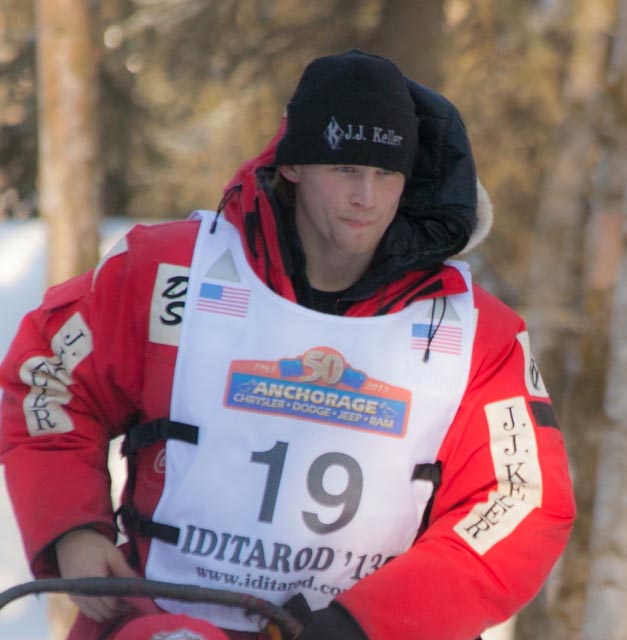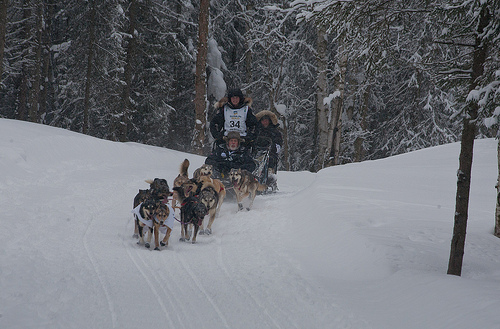
DALLAS SEAVEY INFORMATION FROM WIKIPEDIA COMMONS
Dallas Seavey (born March 4, 1987) is an American dog musher, one of only two mushers to win the Iditarod Trail Sled Dog Race across the U.S. state of Alaska five times: in 2012, 2014, 2015, 2016, and 2021. In 2018 and 2019, Seavey also competed in Europe’s longest sled dog race, Norway’s Finnmarkslopet.
Seavey’s grandfather, Dan Seavey, competed in the first two Iditarod sled dog races in 1973 and 1974, as well as the 1997 and 2012 races. His father, Mitch Seavey, has also competed in multiple Iditarods, winning in 2004, 2013 and 2017.
Iditarod Trail Sled Dog Race
Dallas Seavey is the youngest musher to compete in the Iditarod, beginning his first race on March 5, 2005, the day after turning 18. At the time, he ran his father’s “puppy” team, a team of less-experienced dogs. He swiftly moved into the top ten by the 2009 Iditarod, and in 2012 became the youngest musher to win the Iditarod at age 25, with a finishing time of 9 days, 4 hours, 29 minutes, 26 seconds.
IDITAROD TRAIL SLED DOG RACE FROM WIKIPEDIA COMMONS

The Iditarod Trail Sled Dog Race, more commonly known as The Iditarod, is an annual long-distance sled dog race run in early March. It travels from Anchorage to Nome, entirely within the US state of Alaska. Mushers and a team of 14 dogs, of which at least 5 must be on the towline at the finish line, cover the distance in 8–15 days or more. The Iditarod began in 1973 as an event to test the best sled dog mushers and teams but evolved into today’s highly competitive race.
Teams generally race through blizzards causing whiteout conditions, sub-zero temperatures and gale-force winds which can cause the wind chill to reach −100 °F (−73 °C). A ceremonial start occurs in the city of Anchorage and is followed by the official restart in Willow, a city 80 miles (129 km) north of Anchorage. The restart was originally in Wasilla through 2007, but due to too little snow, the restart has been at Willow since 2008. The trail runs from Willow up the Rainy Pass of the Alaska Range into the sparsely populated interior, and then along the shore of the Bering Sea, finally reaching Nome in western Alaska. The trail is through a rugged landscape of tundra and spruce forests, over hills and mountain passes, and across rivers. While the start in Anchorage is in the middle of a large urban center, most of the route passes through widely separated towns and villages, and small Athabaskan and Iñupiat settlements. The Iditarod is regarded as a symbolic link to the early history of the state and is connected to many traditions commemorating the legacy of dog mushing.
The race is an important and popular sporting event in Alaska, and the top mushers and their teams of dogs are local celebrities; this popularity is credited with the resurgence of recreational mushing in the state since the 1970s. While the yearly field of more than fifty mushers and about a thousand dogs is still largely Alaskan, competitors from fourteen countries have completed the event including Martin Buser from Switzerland, who became the first foreign winner in 1992.
The Iditarod received more attention outside of the state after the 1985 victory of Libby Riddles, a long-shot who became the first woman to win the race. The next year, Susan Butcher became the second woman to win the race and went on to win three more years. Print and television journalists and crowds of spectators attend the ceremonial start at the intersection of Fourth Avenue and D Street in Anchorage and in smaller numbers at the checkpoints along the trail.
Mitch Seavey set the record fastest time for the Iditarod in 2017, crossing the line in Nome in 8 days, 3 hours, 40 minutes and 13 seconds, while also becoming the oldest winner.
TODAY’S ALMANAC
Today is the beginning of Daylight Saving Time, time for moving the clocks one hour ahead. The exceptions are Arizona, Hawaii, Puerto Rico, the Virgin Islands, and American Samoa. Credit for Daylight Saving Time belongs to Benjamin Franklin, who first suggested the idea in 1784. The idea was revived in 1907, when William Willett, an Englishman, proposed a similar system in the pamphlet The Waste of Daylight. The Germans were the first to officially adopt the light-extending system in 1915 as a fuel-saving measure during World War I. The British switched one year later, and the United States followed in 1918, when Congress passed the Standard Time Act, which established our time zones. This experiment lasted only until 1920, when the law was repealed due to opposition from dairy farmers (cows don’t pay attention to clocks). During World War II, Daylight Saving Time was imposed once again (this time year-round) to save fuel.
Question of the Day
Does Vermont have a long enough growing season for red peppers? The green bell type are no problem. How about okra?We are very doubtful about growing red bell peppers in Vermont. If they’re planted in a sheltered valley, if spring comes early, if the summer is hot, hot, hot—then maybe. We don’t advise growing okra either. This plant requires a warm soil and climate, which is why it is associated with the South.
Advice of the Day
Though honey is sweet, do not lick it off a brier.
Home Hint of the Day
When laying a floor, start along the most irregular wall. It’s easier to cut for that wall before laying floorboards that close you in.
Word of the Day
Three Chilly SaintsMamertus, Pancras, and Gervais were three early Christian saints. Because their feast days, on May 11, 12, and 13, respectively, are traditionally cold, they have come to be known as the Three Chilly Saints. An old French saying goes: “St. Mamertus, St. Pancras, and St. Gervais do not pass without a frost.”
Puzzle of the Day
When a person falls out a window, what does he always fall against?Against his will
Born
- Joseph Priestley (scientist) – 1733
- Abigail Fillmore (U.S. First Lady) – 1798
- Percival Lowell (astronomer) – 1855
- Hugo Wolf (composer) – 1860
- Janet Flanner (journalist) – 1892
- Sammy Kaye (bandleader) – 1910
- L. Ron Hubbard (author) – 1911
- Douglas Rain (Canadian actor) – 1928
- Neil Sedaka (singer) – 1939
- William H. Macy (actor) – 1950
- Deborah Raffin (actress) – 1953
- Adam Clayton (bass guitarist for U2) – 1960
- Annabeth Gish (actress) – 1971
Died
- Benjamin Harrison (23rd U.S. president) – 1901
- Susan B. Anthony (reformer) – 1906
- Bruno Bettelheim (child psychologist) – 1990
- Maureen Stapleton (actress) – 2006
- Robert C. Baker (founded Cornell University’s Institute of Food Science and Marketing. He was responsible for many innovations including chicken nuggets and chicken hot dogs) – 2006
- Peter Tomarken (game show host) – 2006
Events
- Harvard University was named for clergyman John Harvard– 1639
- Halley’s Comet reached perihelion– 1759
- The planet Uranus was discovered by English astronomer Sir William Herschel– 1781
- First political cartoon depicting Uncle Sam” published”– 1852
- Confederate Congress agreed on the recruitment of slaves into the army (U.S. Civil War)– 1865
- Chester Greenwood patented earmuffs– 1877
- Eadweard Muybridge’s Zoopraxiscope, an early movie projector, debuted in London– 1882
- Tennessee banned teaching evolution– 1925
- The discovery of Pluto, the ninth planet, was officially announced on this date, which was Percival Lowell’s birthday. Lowell was founder of Lowell Observatory in Flagstaff, Arizona, where Clyde W. Tombaugh discovered Pluto on February 18, 1930. (Much later, Pluto’s planet designation changed!)– 1930
- Hitler took formal possession of Vienna (WWII)– 1938
- The Viet Minh began a successful siege of the French-held Dien Bien Phu in Vietnam– 1954
- Oil discovered in Prudhoe Bay in Alaska– 1968
- U.S. Apollo 9 splashed down in the Atlantic Ocean after a 10-day flight testing the lunar module– 1969
- The Common Market officially inaugurated the new European Monetary System– 1979
- Irving King Jordan, Jr., became the first deaf president of Gallaudet University– 1988
- Solar flare caused power grid failure of Hydro-Quebec in Canada– 1989
- Moscow’s newspaper, Pravda, announced that it was suspending publication– 1992
- UFOs seen over Arizona, Nevada, and Sonora, Mexico– 1997
- For 15 minutes, Luciano Pavarotti took in bravos after the night’s performance of Tosca at the Metropolitan Opera. It was his final night of staged opera; the end of a career that began 43 years earlier. It was the biggest farewell ovation at the Met since soprano Leonie Rysanek said goodbye in January 1996.– 2004
- Twenty-five year old Dallas Seavey became the youngest winner of the Iditarod Trail Sled Dog Race– 2012
- Roman Catholic cardinals elected the church’s first South American leader, Argentine Cardinal Jorge Mario Bergoglio. He took the name Pope Francis I.– 2013
Weather
- Three-day blizzard, Saratoga, New York, 58 inches snow– 1888
- Seventy-three inches of snow depth at Woodstock, Vermont– 1963
- Blizzard in Vermont, New Hampshire, and Maine dumped 3 feet of snow– 1984
- High of 83 degrees F in New York City– 1990
- East coast blizzard dumped heavy snow: 25 inches in Pittsburgh, Pennsylvania; 27 inches in Albany, New York; and 13 inches in Birmingham, Alabama– 1993
COURTESY www.almanac.com

Hi , I do believe this is an excellent blog. I stumbled upon it on Yahoo , i will come back once again. Money and freedom is the best way to change, may you be rich and help other people.